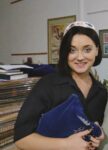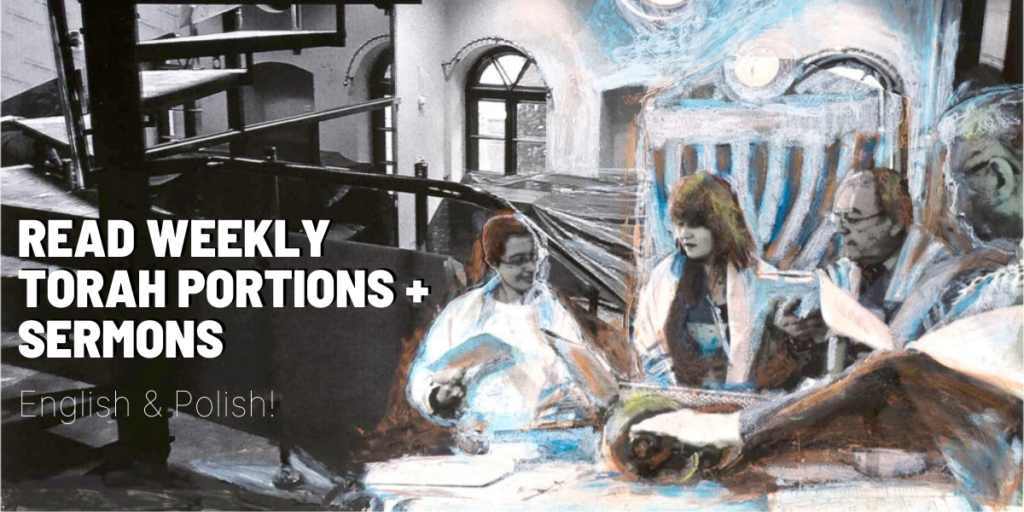
Hathor as a cow suckling Hatshepsut, a female pharaoh, at Hatshepsut’s temple at Deir el-Bahari, 15th century BC
(Shemot 30:11 – 34:35)

Miriam Klimova
[maxbutton id=”6″ url=”https://polishjewsreviving.org/paraszat-ki-tisa/” ] It’s said that whatever we think about has a tendency to come true. But can we control our thoughts?
The mysterious bond between Moshe and the invisible God must have been a source of endless discussions and doubts among the people. At the beginning of parashat Ki Tisa Moshe is alone on the top of Mount Sinai, where he receives detailed instructions from God regarding the building and functioning of the Tabernacle. In the meantime the people of Israel are left alone, without their leader. Uncontrollable thoughts are filling their heads and are sowing a seed of fear in them. The prolonged absence of Moshe provokes deep anxiety – he disappeared! He said that he was going up the mountain to God, but the Israelites, tired of the desert, need God to be down here, next to them. Why is he spending so much time on that mountain? Does God, who needed only one night to dry up the water and to lead the Israelites through the sea, now need forty days and forty nights to carve 10 Commandments on two tablets?! We must act, we must take matters into our own hands! But how? Maybe we should make us a deity, and then God’s power will enter into it and show us the correct path? Moshe is still not coming back, so even more distressing thoughts appear – that this God of his has disappeared along with him, and these thoughts are slowly starting to drive them crazy.
We are tormented by questions about the people’s morality; how could they have come back to idolatry so quickly?! But did they really view the calf as a change of God? Moshe was a visible link to an invisible God. The Israelites did not think that God could be created from the gold of their decorations. This is a mistaken understanding of ancient beliefs. The calf was their new link to God and it was supposed to replace not God, but “this man Moshe”.
Aaron had nothing against this. He was convinced that the people would not believe in a God who cannot be seen. While Moshe demands an unconditional submission to an omnipotent, invisible Deity, Aaron wants to express the idea of God in a way that can be understood. We can assume that this wasn’t strictly speaking idolatry. An abstract idea of divinity poses a great challenge for modern people, not to mention in the ancient times.
Why choose a calf? They have just been saved from Egyptian slavery. More than one generation was born there and of course they were being raised under the influence of the surrounding culture. Indeed the two main incidents of idolatry described in the Tanach are directly connected to ancient Egypt. One – described in parashat Ki Tisa, and the other was initiated by Yeroboam after he successfully took control over the fragmented Israeli kingdom (1 Kings 12). The two stories have several things in common. First of all, in both cases the objects of cult had the shape of calves or caws, and secondly: these events took place in a difficult interim period, when the nation needed a sense of safety and unity. The link to Egypt is not an accident. The ancient Egyptians worshiped several deities which made use of the images of bulls and cows. There was a widespread cult of a heavenly cow – the goddess Hathor, sometimes presented as a cow, and then as a woman with a cow’s head and with a solar disk between the horns. A cow was perceived as life-giving; it sustained life through its milk, it was even said about certain Pharaohs that they were fed by Hathor.
The goddess-cow strengthened, sustained and granted divinity to royal rule. When Yeroboam wanted to further unify his people, he probably made use of “pop-culture”. And similarly the Israelites, while left without a leader, on a hostile territory, with helpless families, in a time of need turned to a familiar cult in order to save themselves in a difficult situation.
Could this incident, which has left such a deep mark in Israel’s memory, have been avoided? Could they have overcome the fear that had poisoned their lives on more than one occasion? Could they have controlled their thoughts?
A similar question is raised in the story “Sipur chasidi”. It describes how a certain Chassid once came to Dov Ber of Mezeritch, called the Great Magid[1], to ask a question and share his doubts if freedom of choice applies to our thoughts as well – “The Torah forbids us to think evil thoughts. But what can we do when evil thoughts come to our mind? Can man control their thoughts?!”. Rather than giving him an answer, the Magid sent him to a remote place, Zhytomyr, to one of his students, rabbi Zeev. In the middle of winter, after weeks of travel, the Chassid knocked on the door, but there was no answer. With nowhere to go, he kept knocking on the door, while the Rabbi himself, just a couple of steps away from him, was reading by a warm fireplace… Finally Rabbi Zeev got up from his chair, he opened the door and welcomed the Chassids with his characteristic kindness and hospitality. After regaining his strength, the Chassid mustered the courage to ask his question. And Rabbi Zeev smiled and said: “I’ve already answered your question”. With his behavior the Rabbi wanted to show that I am the master in my home: “I let in whoever I want, and whoever I don’t want, I keep them outside”.
This story teaches us that every person is the master of their thoughts and only they can decide who can enter and who cannot. If there is chaos in our head, we won’t be able to fulfill our desires, fear will be bringing us down like a heavy stone, and a bad mood will not let us enjoy the rays of sunshine on our face.
The past few years have been a difficult experience for all of us – sickness, decisions about vaccinations, worrying about our loved ones, remote work or even losing one’s job, and also war conflicts. And although Moshe is not present in our lives as well, we shall not give up. And let us thank our ancestors, the Israelites on Sinai, for the possibility to learn from their mistakes.
May there be a will… that we learn how to control our thoughts and actions, so that each one of us can decide autonomously who can enter into our house-mind. After all, positive thinking, optimism and a sense of happiness require conscious skills!
Shabbat Shalom!
Translated from Polish by: Marzena Szymańska-Błotnicka
- Dov Ber (18th century) was a student of Baal Shem Tov and after his death he succeeded him as the Chassidic leader. ↑
















Leave a Reply